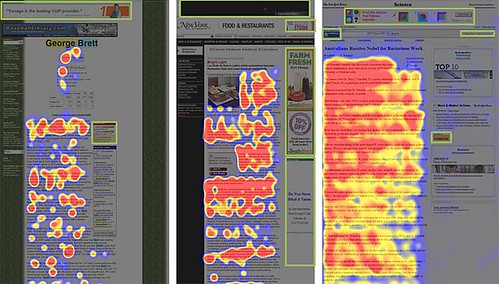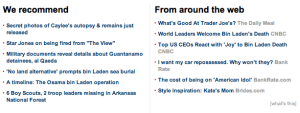The blogs have been aflutter recently with renewed discussion of "in-stream advertising". Mark Suster wrote an eloquent piece in TechCrunch last week proclaiming "the future of advertising will be integrated". My friend, Jon Steinberg, of BuzzFeed has written several posts on the topic, including one entitled Native Monetization, touting monetization that is native and organic to the platform on which it resides. I agree wholeheartedly with both their sentiments, and have for some time. The truth of the matter is that this is hardly a new discussion. Most disruptive shifts - particularly ones in online media and advertising - seem to be decried and predicted many times over many years before they actually take hold. This one is no different.

At Sphere (then later at Surphace), we rode this pony as early as 2008 by championing theuntapped value "below the fold" and we reiterated the argument again in 2009, discussing all the points of action that exist in this area of the page - commenting, sharing, etc. All these activities are integrated in the main content well where readers' focus persists. Mark's reference to Jakob Nielsen's Banner Blindness study (actually conducted in 2007 and referenced in our 2009 post) supports the hypothesis that the more native / integrated / in-stream / in-line you get, the better branding and engagement you will achieve as a marketer or attention-grabber of any form. One of the best posts on this topic was written in early 2007 by UX expert and former Aol employee, Milissa Tarquini, entitled Blasting the Myth of the Fold.
The reason why "the fold" was such a focal point of early discussion of integrated / native / etc advertising is that a publisher can only fit so many things above it. By the time you squeeze in a header, navigation and a few paragraphs of content, you've reached the proverbial fold, and for most of the past decade, online marketers swore off anything below as verboten. This forces marketers to the right rail to preserve their "above the fold" status, but in so doing, into the "banner blindness" zone. In Mark's post in TechCrunch, he suggests Kontera and Vibrant as examples of businesses who have figured out an integrated solution. In both cases, these companies have built significant businesses which deserve respect, but many industry insiders describe their products as disruptive to reader experience, at best, and some choose other less complimentary adjectives. Either way, I don't expect to see these mouse-over pop-up schemes showing up on CNN or NY Times anytime soon and I certainly wouldn't want them on my blog. Integrated?, yes. Native?, maybe. Organic?, no way.
At Outbrain (and Surphace before), we've always been big believers in non-interruptive marketing experiences. In addition to being integrated and native and in-stream, it's also essential to reach a reader without disrupting or jarring their flow. This is what non-interruptive means. John LoGioco laid it out beautifully in a post this past March in response to Fred Wilson's article explaining everything he hates about marketing. Non-interruptive means capturing the reader's focus organically; with such subtlety that they don't even realize you've done it. No smiley, blinky icons flashing before their eyes. No annoying display ads taking over the page, prompting readers to frantically search for the elusive "x" button to force an exit. No autoplay audio/video or unavoidable mouse-over triggers. These are all examples of disruptive marketing. Outbrain offers marketers a unique opportunity to engage with readers in-stream without offending anyone. We do it so subtly that readers usually don't even know they've been hit. This is what integrated and native monetization is all about.
 Mark references average click-through rates (CTR) of online display ads hovering in the 0.2% range. Those who have worked in the industry awhile would probably agree that this figure seems stagnant, unchanged over many years, meaning online display advertising hasn't become any more effective. If I were a media planner buying display inventory, this might be somewhat concerning. At Outbrain, our network average CTR is near 6% and continues to climb. This means 6% of the readers who interact with a page where we live engage with our content/ads. To spell that out, that's 300x (30,000%) the average interaction rate of display ads. Further, each sponsored article/link we promote - consuming roughly 1/10th the size of a 300x250 box ad - garners a higher CTR, on average, than 0.2%. In most cases, it's quite a bit higher. The reason we're able to achieve this performance is precisely because readers don't distinguish our products from the core content they're there to consume. It's "integrated". If I were Chief Marketing Officer for a big brand or someone controlling the purse strings for an agency, I know where I'd choose to spend my money. How about you?
Mark references average click-through rates (CTR) of online display ads hovering in the 0.2% range. Those who have worked in the industry awhile would probably agree that this figure seems stagnant, unchanged over many years, meaning online display advertising hasn't become any more effective. If I were a media planner buying display inventory, this might be somewhat concerning. At Outbrain, our network average CTR is near 6% and continues to climb. This means 6% of the readers who interact with a page where we live engage with our content/ads. To spell that out, that's 300x (30,000%) the average interaction rate of display ads. Further, each sponsored article/link we promote - consuming roughly 1/10th the size of a 300x250 box ad - garners a higher CTR, on average, than 0.2%. In most cases, it's quite a bit higher. The reason we're able to achieve this performance is precisely because readers don't distinguish our products from the core content they're there to consume. It's "integrated". If I were Chief Marketing Officer for a big brand or someone controlling the purse strings for an agency, I know where I'd choose to spend my money. How about you?